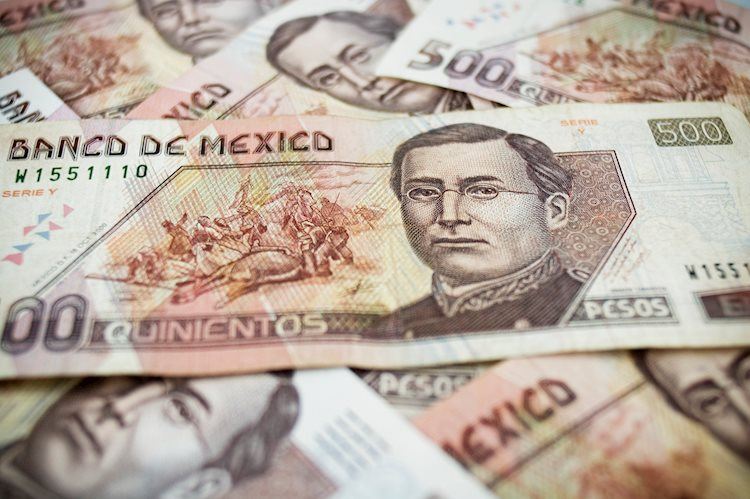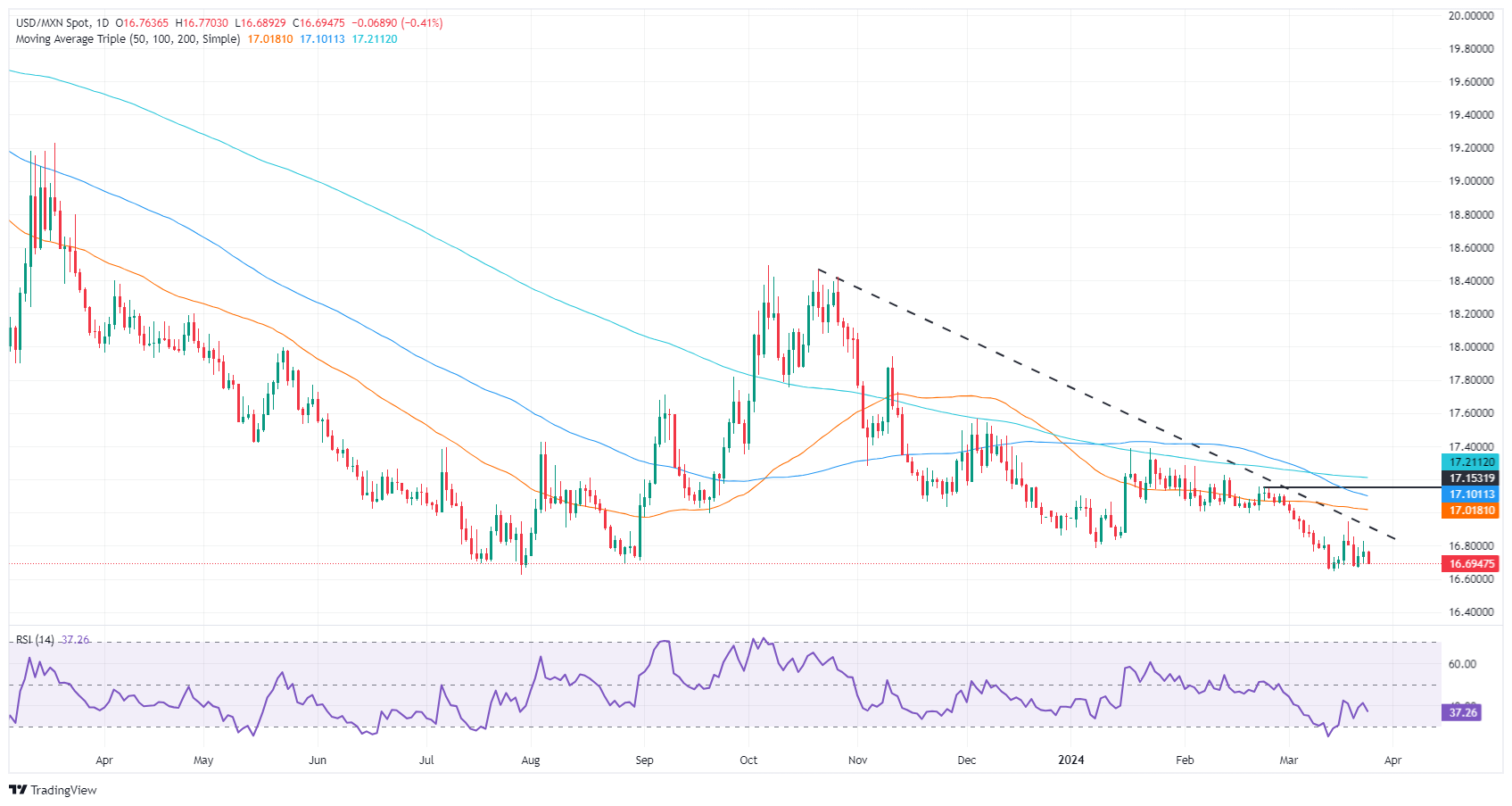- Mexican Peso benefits from US Dollar weaknesses, shrugging off Banxico rate cut.
- Banxico Governor emphasized cautious approach to rate adjustments, stressing ongoing inflation battle.
- Mixed economic updates from both Mexico and the US leave traders weighing Fed’s rate cut discourse against actual data.
The Mexican Peso capitalized on broad US Dollar weakness on Monday, climbing more than 0.1% in the mid-North American session. A risk-off impulse was no excuse for the Mexican currency’s bulls despite last week’s interest rate cut by the Bank of Mexico (Banxico). Additionally, traders ignored comments from Federal Reserve’s (Fed) members as the Greenback remains pressured. The USD/MXN trades at 16.69, down 0.28%.
Mexico’s economic docket is absent, though Banxico Governor Victoria Rodriguez Ceja crossed the wires. She said that the first rate cut does not mean the battle against inflation is over. She added that the central bank would be gradual, and adjustments to the main reference rates would be made taking into account upcoming data.
Last week, the National Statistics Agency (INEGI) revealed that the economy shrunk in January from December, while mid-month inflation increased on a monthly and annual basis.
Across the border, Federal Reserve officials had crossed the newswires. Atlanta Fed President Raphael Bostic said that he favors one rate cut this year, while Chicago Fed President Austan Goolsbee foresees three decreases to the fed funds rate (FFR). At the same time, Fed Governor Lisa Cook commented that a premature rate cut could increase the risk of inflation becoming entrenched.
The US schedule features housing market data, the Chicago Fed National Activity Index and the Dallas Fed Manufacturing Index.
Daily digest market movers: Mexican Peso capitalizes on US Dollar weakness on Monday
- Banxico Governor Victoria Rodriguez Ceja said, “When macroeconomic conditions and the inflationary outlook allow us to make additional adjustments to the reference rate to the one we already have, I consider that they would be gradual.”
- Mexico’s economy contracted for the fourth time in January. The Indicator of General Economic Activity plunged -0.6% MoM, below estimates of a 0.3% expansion, and slowed compared to December, missing estimates of 2.6% to print at 2%. Inflation in Mexico exceeded estimates of 4.45%, increasing by 4.48%, while core figures jumped above the consensus of 4.62% YoY to 4.69%.
- The outlook in Mexico suggests the economy is stagnating. A weak retail sales report, private spending falling sharply, and a contraction in economic activity justified Banxico’s rate cut. Nevertheless, they face stubbornly stickier inflation, keeping policymakers on their toes.
- The US economic calendar has featured Fed speakers led by Atlanta Fed President Raphael Bostic, who said he expects just one rate cut this year, adding that cutting rates too soon could be more disruptive. At the same time, his colleague, Chicago Fed President Austan Goolsbee, adheres to the majority of the board and expects three cuts, though he said he needs more evidence of inflation “coming down.”
- Recently, Fed Governor Lisa Cook echoed Bostic’s comments, saying that cutting too soon increases the risk of inflation becoming entrenched. She added that the Fed’s dual mandate goals are moving toward better balance.
- New Home Sales for February decreased -0.3% MoM from 0.664 million to 0.662 million. The Chicago Fed National Activity Index improved from -0.54 to 0.05. According to the Chicago Fed, all four categories that compose the index improved on the month.
- Recently, the Dallas Fed Manufacturing Index plunged further from -11.3 in February to -14.4 in March. Wages and prices increased during the month, while expectations for future manufacturing activity generally improved.
Technical analysis: Mexican Peso gathers momentum as USD/MXN falls below 16.70
The USD/MXN remains downwardly biased after hitting 16.94, last week’s high. Since then, the exotic pair has tumbled 1.45% and is poised to register additional losses. If the pair drops below the current year’s low of 16.64, that could clear the path to test last year’s cycle low of 16.62 and October 2015’s low of 16.32.
For a bullish scenario, traders must reclaim the current week’s high of 16.94, ahead of the 17.00 figure. Up next lie key dynamic resistance levels like the 50-day Simple Moving Average (SMA) at 17.01, the 100-day SMA at 17.11, and the 200-day SMA at 17.20.
USD/MXN Price Action – Daily Chart
Banxico FAQs
The Bank of Mexico, also known as Banxico, is the country’s central bank. Its mission is to preserve the value of Mexico’s currency, the Mexican Peso (MXN), and to set the monetary policy. To this end, its main objective is to maintain low and stable inflation within target levels – at or close to its target of 3%, the midpoint in a tolerance band of between 2% and 4%.
The main tool of the Banxico to guide monetary policy is by setting interest rates. When inflation is above target, the bank will attempt to tame it by raising rates, making it more expensive for households and businesses to borrow money and thus cooling the economy. Higher interest rates are generally positive for the Mexican Peso (MXN) as they lead to higher yields, making the country a more attractive place for investors. On the contrary, lower interest rates tend to weaken MXN. The rate differential with the USD, or how the Banxico is expected to set interest rates compared with the US Federal Reserve (Fed), is a key factor.
Banxico meets eight times a year, and its monetary policy is greatly influenced by decisions of the US Federal Reserve (Fed). Therefore, the central bank’s decision-making committee usually gathers a week after the Fed. In doing so, Banxico reacts and sometimes anticipates monetary policy measures set by the Federal Reserve. For example, after the Covid-19 pandemic, before the Fed raised rates, Banxico did it first in an attempt to diminish the chances of a substantial depreciation of the Mexican Peso (MXN) and to prevent capital outflows that could destabilize the country.

